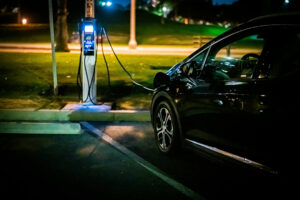
Chipmakers see opportunity in growth of EVs, hybrids as gov’t weighs tariff changes
By Justine Irish D. Tabile, Reporter
THE semiconductor industry will be among the industries that expect to benefit from growing electric vehicle (EV) and hybrid electric vehicle (HEV) adoption, the chip industry association said.
Danilo C. Lachica, president of Semiconductor and Electronics Industries in the Philippines Foundation, Inc., told reporters on the sidelines of a briefing on Tuesday that electronics account for 90% of the components of both EVs and HEVs.
“So, yes, it does open up opportunities. But the thing is, until we have the infrastructure for EVs, like more charging stations and fast charging stations, personally, I’d rather go with hybrids first,” Mr. Lachica said.
“Eventually, EV will be the way to go. It’s hard to persuade jeepney drivers or even bus operators to wait 10 hours to charge an EV. We have to make sure that we have abundant fast charging stations for commercial use,” he added.
In March, the Tariff Commission held a public consultation to discuss the possible expansion of the coverage of Executive Order (EO) 12, which imposed zero tariffs on various types of EVs in order to promote green transport and cut carbon emissions.
The National Economic and Development Authority has proposed to add e-motorcycles and HEVs to the EO’s coverage.
The Department of Energy has said that the expanded coverage will help meet the targets of the Comprehensive Roadmap for the Electric Vehicle Industry (CREVI), while the Department of Trade and Industry has taken the position that expanded coverage will hinder efforts to rapidly expand the charging station network.
The coverage expansion is supported by the Chamber of Automotive Manufacturers of the Philippines, Inc., which said that the Philippines is recording growth in hybrid adoption, although the CREVI targets remain out of reach.
Trade Secretary Alfredo E. Pascual said a committee will meet on Friday to discuss the proposed expansion.
“We will consider their arguments, of course. But as we explained, the motivation for the lifting of the tariff on EVs is very clear: to increase the car population with electric engines for purposes of encouraging the setting up of charging stations,” Mr. Pascual told reporters on Monday.
“Hybrids do not need charging stations, and to be able to boost EV population, we need charging stations. And charging stations will only be set up if there are enough EVs to patronize them; that is why we are prioritizing EVs first,” he added.
For the meeting on Friday, Mr. Pascual said the committee will discuss whether there is room to broaden the scope of the EO.
“When the decision was reached to (remove) the tariff on EVs, it was very clear in our minds why we did it: to encourage the setting up of charging stations,” he said.
“Now we are going to broaden our scope… but I cannot speculate now because this is committee work,” he added.



